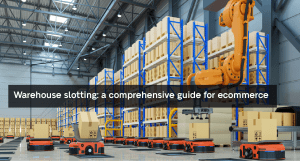The warehousing and logistics industry is facing a series of challenges. Companies have to keep costs under control, expand their reach, and optimize the operations of their entire network of facilities. It’s not easy to tackle such challenges with so many variables at play. But implementing a logistics WMS software can give your business the tools it needs to succeed by automating manual processes, streamlining your supply chain, and reducing costs across all areas of operation. This blog post will help you understand what a WMS is for and why it is essential for most e-commerce companies that have outsourced warehouse management, as well as some best practices that will help you implement a management system in a fluid and effective way.
What is WMS?
A warehouse management system (WMS) is an integrated suite of software that helps organizations optimize warehouse and logistics operations. These systems are designed to improve inventory visibility, picking, scalability, and coordination across the supply chain. A WMS system is a fundamental element for today’s e-commerce. It is a warehouse management software that helps companies track and organize all operations. When a problem occurs with a customer’s order, a logistics WMS can help the company identify the problem quickly and easily, preventing the situation from escalating. This type of tracking is useful for any manufacturer, whether you work in the retail sector or in another industry that needs to store, ship and track products.
Why is the warehouse so important?
Automated warehouses serve as both the epicenter of inventory and the main hub for all transits. That’s why a warehouse management software is so essential to the health of any company, elevating the performance of the various stages of the supply chain. The warehousing process, for example, is at the heart of any supply chain. Here products are received from suppliers, then picked, packed and shipped to customers.
A WMS system for logistics can track inventory levels and help businesses better forecast demand, as well as help them increase the amount of goods they can pick per shift, because all manual and error-prone processes are eliminated. Because of their central role, warehouses are responsible for a huge part of the costs of any operation, generating a significant portion of a company’s expenses. For this reason it is essential to optimize and control these costs. A WMS can help you do this by streamlining picking processes, reducing the need for extra manpower, and improving space management.
What is warehouse management?
How can a WMS help warehouse logistics? To best leverage all its potential, a logistics wms system must be integrated with other systems to allow data to be extracted and connected to the warehouse management one. In this way you can use the Logistics WMS to manage all aspects of your operations from a single interface, such as:
– Inventory management
– Traceability of resources
– Warehouse management
– Management of picking and packaging
– Transport management
– Inventory verification (for example, serialization).
A warehouse management software provides the necessary tools to create workflows that streamline each phase of the warehouse process. It is also possible to use a WMS to create a real integrated ecosystem, such as the one offered by eLogy to better manage ecommerce logistics services. This includes integrating the WMS with other software solutions, such as ERP, CRM and shipping systems.
If you want to implement a logistics WMS system, the first thing to do is conduct a thorough warehouse audit. This will help you understand how your warehouse is currently set up, how it works and where there might be opportunities for improvement. Once the audit is complete, a plan can be created to implement a logistics WMS software. This includes choosing a WMS that is right for you and determining the features that are most essential to your business.
Three phases to implement a WMS logistics software
WMS should only be implemented after a thorough warehouse audit. This will help you understand how your warehouse is currently set up, how it works and where there might be opportunities for improvement. Once the audit is complete, a results-based plan can be created to implement a WMS. To recap, you need to:
– Define clear corporate objectives. A wms must be implemented only after defining clear objectives. This will help you determine which WMS features are most important to your business. Having a clear understanding of what you want to achieve will also help you select the right WMS for your business.
– Hire the right team. You need a team of experts who have the skills to successfully implement a WMS. This includes project managers, business analysts, architects and developers. Hiring professionals for each of these roles is essential to ensure that your WMS implementation goes smoothly.
– Be patient. Implementing a WMS will require considerable effort and resources. Even if it is possible to finish the project in a short time, it is better to take the time necessary to do it well.
A successful warehouse logistics WMS implementation will help you manage your warehouse more efficiently. It will also improve inventory management and provide a better insight into operations.
Conclusions
Warehouse management systems help manage the flow of goods across your supply chain. They provide the tools to sell online without inventory while tracking inventory, managing shipments, and optimizing space usage. A WMS is a fundamental part of an end-to-end supply chain management service. It is a software solution that helps companies track and organize everything that happens in their automated warehouses. This includes inventory management, asset tracking, warehouse management, pick and pack management, transportation management, and inventory tracking.




